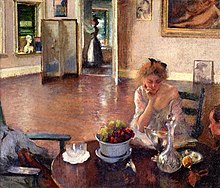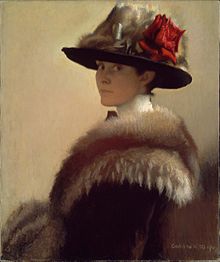Boston school (painting)
Often classified as American Impressionists, they had their own regional style, combining the painterliness of Impressionism with a more conservative approach to figure painting and a marked respect for the traditions of Western art history.
Their interest in modern French art can be traced to William Morris Hunt, a well-known teacher, painter, and taste-maker in late nineteenth-century Boston.
After a visit to Paris, Hunt, who was on the original advisory board of the Museum of Fine Arts, encouraged prominent Bostonians to invest in the work of French artists such as Millet, Monet, and Renoir.
Later they gravitated to indoor scenes, typically featuring women engaged in household duties, recalling the domestic subjects of Dutch painters such as Vermeer.
"[3] They placed a high value on technical skill, accurate visual representation, and classical beauty, while adopting what was then a very modern, "loose" style of painting from the French.
[4] Other painters associated with the Boston school include Joseph DeCamp,[5] Philip Leslie Hale,[6] Lilian Westcott Hale,[7] John Joseph Enneking,[2] Gretchen Woodman Rogers,[8] Aldro Hibbard,[2] Frederic Porter Vinton,[9] Lilla Cabot Perry,[10] Elizabeth Okie Paxton,[11] Hermann Dudley Murphy,[12] W. Lester Stevens,[13] and others.
[15] Later artists working in this style include R. H. Gammell,[6] Yoshi Mizutani,[16] Charles Tersolo, Thomas R Dunlay, Melody Phaneuf, Sam Vokey,[17] Candace Whittemore Lovely,[18] and Dianne Panarelli Miller.


